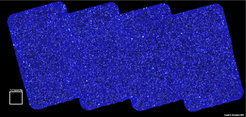ERC consolidator grant for Dr. Esra Bulbul
The project "DarkQuest: Shedding Light on the Nature of Dark Matter and Dark Energy with Multi-Wavelength All-Sky Surveys" led by Esra Bulbul at MPE is being funded by an ERC Consolidator grant for the next five years. Taking advantage of the eROSITA survey data, she aims to constrain dark energy and dark matter models.

Galaxy clusters are massive objects, dominated by dark matter. Located at the nodes of the cosmic web, they provide a representative view of the distribution of dark matter, the most abundant matter in the Universe. Their abundance as a function of redshift and mass is a sensitive probe of the growth of structure in the Universe, and hence the underlying cosmological parameters. As we enter the decade for precision cosmology, Dr. Esra Bulbul aims to constrain dark energy and dark matter models by taking advantage of the most recent eROSITA survey through her ERC Consolidator Grant. eROSITA is one of the next generation cosmology experiments that will provide cosmological parameters with percent-level precision.
The ERC project, entitled "DarkQuest: Shedding Light on the Nature of Dark Matter and Dark Energy with Multi-Wavelength All-Sky Surveys", will receive 2 million euros, the maximum amount awarded by the ERC for such competitions. The ERC Consolidator Grants are awarded to outstanding researchers of any nationality and age, with at least seven and up to twelve years of experience after PhD, and a scientific track record showing great promise. Research must be conducted in a public or private research organisation located in one of the EU Member States or “Associated” Countries. In this year’s application round, the success rate was 13%.

The final equatorial depth mini survey (eFEDS) observed during the eROSITA Performance Verification phase has already delivered better results than predicted. In this region of 140 square degrees a total of 540 extended sources was detected. With the eROSITA all-sky survey, the scientists expect to detect approximately 100,000 galaxy clusters in the Universe.
Dr. Bulbul currently holds a group leader position at MPE and is the lead scientists for the eROSITA cluster science and cosmology working group. Before joining MPE in 2019, she worked as a staff scientist at the Harvard-Smithsonian Center for Astrophysics. She has held postdoctoral fellowships at the Massachusetts Institute of Technology, the Harvard-Smithsonian Center for Astrophysics, and the NASA Goddard Space Flight Center. She received her Ph.D. in Physics from the NASA Marshall Space Flight Center in December 2010.













